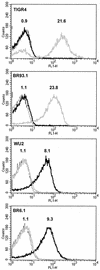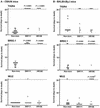Relative roles of genetic background and variation in PspA in the ability of antibodies to PspA to protect against capsular type 3 and 4 strains of Streptococcus pneumoniae
- PMID: 12874329
- PMCID: PMC166025
- DOI: 10.1128/IAI.71.8.4498-4505.2003
Relative roles of genetic background and variation in PspA in the ability of antibodies to PspA to protect against capsular type 3 and 4 strains of Streptococcus pneumoniae
Abstract
Pneumococcal surface protein A (PspA) is able to elicit antibodies in mice and humans that can protect mice against fatal infection with Streptococcus pneumoniae. It has been observed that immunization with a single family 1 PspA can protect mice against infections with capsular type 3 or 6B strains expressing PspA family 1 or 2. However, several studies have shown that immunity to PspA is less efficacious against several capsular type 4 strains than against strains of capsular types 3, 6A, and 6B. To determine whether the greater difficulty in protecting against capsular type 4 strains resulted from differences in their PspAs or from differences in their genetic backgrounds, we performed protection experiments using four different challenge strains: a capsular type 3 strain expressing a family 1 PspA (WU2), a capsular type 4 strain expressing a family 2 PspA (TIGR4), and genetically engineered variants of WU2 and TIGR4 expressing each other's PspAs. Prior to infection, the mice were immunized with recombinant family 1 or family 2 PspA. The results revealed that much of the difficulty in protecting against capsular type 4 strains was eliminated when mice were immunized with a homologous PspA of the same PspA family. However, regardless of which PspA the strains expressed, those on the TIGR4 background were about twice as hard to protect against as WU2 strains expressing the same PspA based on the efficacy rates seen in our experiments. These results point out the importance of including more than one PspA in any PspA vaccines developed for human use.
Figures




Similar articles
-
Protective Immune Responses Elicited by Fusion Protein Containing PsaA and PspA Fragments.Immunol Invest. 2015;44(5):482-96. doi: 10.3109/08820139.2015.1037956. Immunol Invest. 2015. PMID: 26107747
-
The genetic background of Streptococcus pneumoniae affects protection in mice immunized with PspA.FEMS Microbiol Lett. 2007 Apr;269(2):189-95. doi: 10.1111/j.1574-6968.2006.00516.x. Epub 2007 Mar 13. FEMS Microbiol Lett. 2007. PMID: 17355599
-
Analysis of serum cross-reactivity and cross-protection elicited by immunization with DNA vaccines against Streptococcus pneumoniae expressing PspA fragments from different clades.Infect Immun. 2002 Sep;70(9):5086-90. doi: 10.1128/IAI.70.9.5086-5090.2002. Infect Immun. 2002. PMID: 12183557 Free PMC article.
-
Systemic and mucosal protective immunity to pneumococcal surface protein A.Ann N Y Acad Sci. 1996 Oct 25;797:118-26. doi: 10.1111/j.1749-6632.1996.tb52954.x. Ann N Y Acad Sci. 1996. PMID: 8993356 Review.
-
A Jack of All Trades: The Role of Pneumococcal Surface Protein A in the Pathogenesis of Streptococcus pneumoniae.Front Cell Infect Microbiol. 2022 Feb 2;12:826264. doi: 10.3389/fcimb.2022.826264. eCollection 2022. Front Cell Infect Microbiol. 2022. PMID: 35186799 Free PMC article. Review.
Cited by
-
Relationship between surface accessibility for PpmA, PsaA, and PspA and antibody-mediated immunity to systemic infection by Streptococcus pneumoniae.Infect Immun. 2005 Mar;73(3):1304-12. doi: 10.1128/IAI.73.3.1304-1312.2005. Infect Immun. 2005. PMID: 15731027 Free PMC article.
-
Interaction of pneumococcal histidine triad proteins with human complement.Infect Immun. 2010 May;78(5):2089-98. doi: 10.1128/IAI.00811-09. Epub 2010 Mar 1. Infect Immun. 2010. PMID: 20194599 Free PMC article.
-
Vaccine-induced human antibodies to PspA augment complement C3 deposition on Streptococcus pneumoniae.Microb Pathog. 2008 Mar;44(3):204-14. doi: 10.1016/j.micpath.2007.09.007. Epub 2007 Oct 11. Microb Pathog. 2008. PMID: 18006268 Free PMC article.
-
Mucosal immunization with an unadjuvanted vaccine that targets Streptococcus pneumoniae PspA to human Fcγ receptor type I protects against pneumococcal infection through complement- and lactoferrin-mediated bactericidal activity.Infect Immun. 2012 Mar;80(3):1166-80. doi: 10.1128/IAI.05511-11. Epub 2011 Dec 12. Infect Immun. 2012. PMID: 22158740 Free PMC article.
-
Invasive and noninvasive Streptococcus pneumoniae capsule and surface protein diversity following the use of a conjugate vaccine.Clin Vaccine Immunol. 2013 Nov;20(11):1711-8. doi: 10.1128/CVI.00381-13. Epub 2013 Sep 4. Clin Vaccine Immunol. 2013. PMID: 24006139 Free PMC article.
References
-
- Aaberge, I. S., J. Eng, G. Lermark, and M. Lovik. 1995. Virulence of Streptococcus pneumoniae in mice: a standardized method for preparation and frozen storage of the experimental bacterial inoculum. Microb. Pathog. 18:141-152. - PubMed
-
- Alexander, J. E., R. A. Lock, C. C. Peeters, J. T. Poolman, P. W. Andrew, T. J. Mitchell, D. Hansman, and J. C. Paton. 1994. Immunization of mice with pneumolysin toxoid confers a significant degree of protection against at least nine serotypes of Streptococcus pneumoniae. Infect. Immun. 62:5683-5688. - PMC - PubMed
-
- Black, S., H. Shinefield, B. Fireman, E. Lewis, P. Ray, J. R. Hansen, L. Elvin, K. M. Ensor, J. Hackell, G. Siber, F. Malinoski, D. Madore, I. Chang, R. Kohberger, W. Watson, R. Austrian, K. Edwards, et al. 2000. Efficacy, safety and immunogenicity of heptavalent pneumococcal conjugate vaccine in children. Pediatr. Infect. Dis. J. 19:187-195. - PubMed
Publication types
MeSH terms
Substances
Grants and funding
LinkOut - more resources
Full Text Sources
Other Literature Sources

